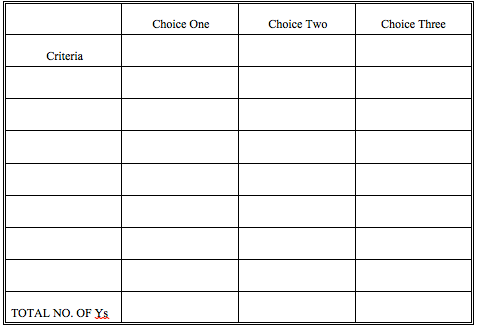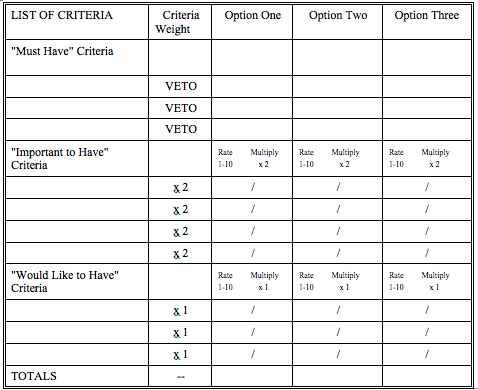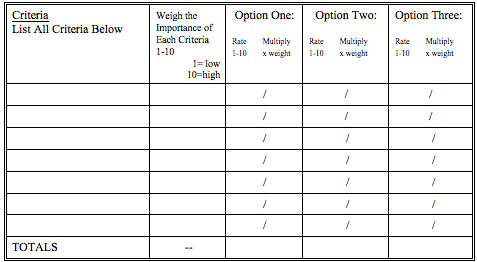“I want to make sure that the groups I facilitate are making sound decisions based on agreed-upon criteria, not just on the whims and fancies of the moment. What do you suggest?”
#8 Criteria Matrix
What is Criteria Matrix?
Criteria Matrix is a technique designed to prioritize a group of potential alternatives under consideration. This is accomplished by identifying and weighing agreed-upon criteria against each of those alternatives. Establishing criteria forces a group to articulate and examine their values, rationales, and assumptions before making their decision.
Criteria are standards from which one makes judgments or decisions, and their identification become the basis for evaluation. For example, if your work group wants to buy a specific piece of equipment and you have a maximum of $20,000 to spend, this amount becomes a criterion. Any equipment over that amount does not meet your criterion and therefore you would not likely choose it. Once all the criteria for the equipment you want to purchase are identified and agreed upon (cost, specifications, quality, warranties, maintenance schedules, etc.) your group can investigate the alternatives more objectively.
It is much easier to reach consensus when making a decision if the criteria are identified and agreed upon beforehand. People are much more willing to give up their favorite choices when they see that these favorites don’t meet the necessary criteria. If there is no agreement on the criteria up front, it is less likely that there will be agreement on the best alternative when it comes time to make the decision.
It is important to recognize that not all criteria are of equal importance and they should therefore have different weightings during the decision making process.
When to Use Criteria Matrix
- When a decision has many components or criteria which must be factored
- When a potential decision is going around in circles without resolve
- When several opinions and perspectives must be considered
- When it is difficult to choose between many choices or alternatives to make a decision
How to Use Criteria Matrix
Before the Meeting
Prepare a chart or overhead for the Criteria Matrix you plan to use in your meeting. Refer to the three examples below for templates.
During the Meeting
1. Brainstorm and agree all criteria that must be satisfied to make the best decision for the problem or situation under consideration. Include criteria from all stakeholders, in addition to any emotionally based and political criteria.
NOTE: Stakeholders are defined as anybody who has a stake in the end result or anyone who will be impacted by the decision to be made.
NOTE: If necessary, help the group understand what criteria are by asking them some open ended questions. You might ask, for example, “What are the qualities or attributes of a good solution?” “What distinguishes between a good and a bad alternative in your mind?” “What standards does an alternative have to meet in order to be acceptable?”
2. Brainstorm all options to a specific problem or situation. Create a short list of serious contenders.
NOTE: It is preferable to determine the criteria in advance of creating the short list of options. This will diminish the chance of forcing criteria to fit a favored option.
3. Introduce the Criteria Matrix you have selected to use for this meeting. Variation 1 functions best when all criteria have basically the same weight and the decision is not terribly complex. Use Variation 2 when clear veto criteria exist. Variation 3 is your best choice when no veto criteria exist, the decision is quite complex, and criteria differ widely in importance.
NOTE: You might want input from some participants in advance of the meeting on the selection of which Criteria Matrix to use.
4. Rate your short list of choices against your criteria using one of the three following variations:
Variation 1
a. List your criteria down the left side of the chart.
b. List your potential choices along the top.
c. Analyze each choice against each criterion. If the criterion is met, mark a Y for yes in the box. If the criterion is not met, mark the box with a N for no.
d. Count the number of Ys for each choice. Write that number in the space provided at the bottom of the chart.
Variation 2
a. Create three categories for your criteria, as illustrated above, and list your criteria based on these categories down the left side of the chart.
(1) The “Must Have” section: If these criteria are not met, the choice is immediately dropped, as noted by the VETO in the Weight section along the top of the chart.
(2) The “Important to Have” section: Failure to meet these criteria is important, but not so important as to veto the choice. You will note that each of these criteria are weighted times 2, double the weight of the next category.
(3) The “Want to Have” section: These criteria are important enough for mention, but not as important as the other two categories, as noted by the times 1 weighting.
b. List your brainstormed choices along the top of the chart.
c. Compare each potential choice against all the selected criteria.
(1) If a choice doesn’t meet a veto criteria, it is dropped from further consideration.
(2) In the times 2 weighting section, apply a numerical rating from 1-10 to show how well the group believes that the option meets the specific criteria. 1 would indicate that the option poorly meets that criteria. 5 would indicate that it satisfactorily meets the criteria. 10 would mean that the criteria was exceeded. Write those numbers on the left side of the column.
(3) In the times 1 weighting section, apply the same numerical rating from 1-10 to show how well the group believes that the option meets the criteria. Write those numbers on the left side of the column.
d. Multiply all choices that weren’t vetoed by their weighting factor. Place the resulting number on the right side of the appropriate box.
e. Add all the resulting factored numbers from each choice at the bottom of each column to arrive at a final rating.
Variation 3
a. List your criteria down the left side of the chart as illustrated above.
b. Have the group rate the importance of each of these criteria on a scale of 1 (low – not important) to 10 (high – very important).
NOTE: More than one criteria could receive the same rating.
c. List your brainstormed choices along the top of the chart.
d. Weigh each choice against each criteria on a scale of 1 (low in meeting this criteria) to 10 (high in meeting this criteria). Write this number in the left side of the column for each choice.
NOTE: When there is controversy about a rating, take time to understand the points of all participants. Sometimes your group will need to further clarify the meaning of a specific criterion or the components of a specific choice. Once all opinions are understood, look for a number that all your participants can support. This is usually the mean number.
e. Multiply the weight of each criteria by the weight given to each choice, and write the resulting number in the right side of the appropriate column.
f. Add the resulting numbers together and write the total at the appropriate location at the bottom of the chart.
NOTE: For all choices, please modify the Criteria Matrix grids based on the number of criteria and choices your group will analyze.
5. Using the completed Criteria Matrix, analyze the results as a group. Use this as data for helping the group make the final decision.
NOTE: The Criteria Matrix provides information to help guide your group to make the best decision. It is possible, although not probable, that groups will make a decision that is not the option supported by the Criteria Matrix.
NOTE: If none of your options ranked well against the criteria, your group may need to consider going back to the drawing board.
In Summary:
Criteria Matrix is a technique designed to prioritize a group of potential alternatives under consideration.
Before the Meeting
Prepare a chart or overhead for the Criteria Matrix you plan to use in your meeting.
During the Meeting
1. Brainstorm and agree all criteria to be considered.
2. Brainstorm all options to a specific problem or situation, creating a short list of serious contenders.
3. Introduce the Criteria Matrix you have selected.
4. Rate your short list of choices against your criteria using one of the following three options.
Variation 1
a. List your criteria down the left side.
b. List your brainstormed choices along the top.
c. Analyze each criteria against each choice. If the criterion is met, mark a Y for yes in the box. If the criterion is not met, mark the box with a N for no.
d. Count the number of Ys for each choice. Write that number in the space provided at the bottom of the chart.
Variation 2
a. Create three categories for your criteria and list your criteria based on these categories down the left side of the chart.
(1) “Must Have/Veto” criteria
(2) “Important to Have” criteria
(3) “Want to Have” criteria
b. List your brainstormed choices along the top of the chart.
c. Compare your choices against all the selected criteria.
(1) If a choice does not meet a veto criteria, drop it from further consideration.
(2) In the “Important to Have” section, apply a numerical rating from 1-10 to show how well the group feels each option meets the specific criteria.
(3) In the “Want to Have” section, apply the same numerical rating from 1-10 to each option.
d. Multiply all choices that were not vetoed by their weighting factor.
e. Add together the resulting factored numbers from each choice at the bottom of each column to arrive at a final rating.
Variation 3
a. List your criteria down the left side of the chart.
b. Have your group rate these criteria by their importance on a scale of 1-10.
c. List your brainstormed choices along the top of the chart.
d. Weigh each choice against each criteria of 1-10, writing this number in the left side of the column.
e. Multiply the weight of each criteria by the weight given to each choice, writing the number in the right side of the appropriate column.
f. Add the resulting numbers together and write to total at the bottom of the chart.
5. Using the completed Criteria Matrix, analyze the results as a group. Use this data for helping the group make the final decision.
OPTION 2 Source:
William Daniels, Group Power. San Diego: Pfeiffer, 1986
———————-
NOTE: If you would like to receive e-mail notification when I post additional techniques, please sign up through this link. http://eepurl.com/KILan You may unsubscribe at any time.
You will find my book Mission Critical Meetings: 81 Practical Facilitation Techniques on Amazon.


